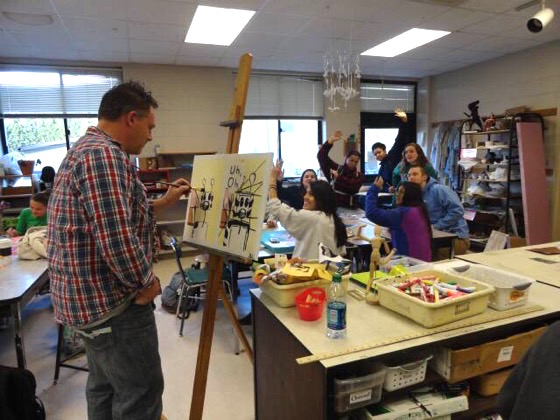Last month I wrote an article about making time to make art. Though I wrote about teachers needing a specific place to make art, like a home studio or rented space, I left out one of the more obvious locations — the art room.
Considering it from the merit of space alone, the art room is a nearly perfect place to make art. Many art rooms contain large windows providing ample, natural light. These facilities are usually well-equipped with sinks, drying racks, and plenty of storage. There is a wide variety of materials on hand and media from which to select. There is only one difference between a home or rented studio and your classroom… The art room comes complete with a set of 30 students.
This raises one consideration. Should an art teacher make art in the art room?
Yes! Make Art!
The proponents of creating art while students are working cite one major advantage. Students benefit from observing a working artist in the room. First, it is important for the students to know that their teacher is a working artist. It raises their respect for their teacher as they view their instructor not only as some one who tells but someone who does. Teachers who paint or otherwise create in their classrooms are quick to point out that the students learn by observation. They see how the teacher masters techniques and skills which they may apply to their own work.
No! Students First!
Opponents to making art during class time question how those who do it find the time. These teachers claim to be constantly on the move, addressing student concerns. Any attempt to work in class would be continually disrupted by student questions. They simply couldn’t focus on both their students’ needs and the concentration needed to complete their own art.
Yes, But…
There is a group of teachers who claim the middle ground. These teachers create art while at the same time addressing student concerns. They accomplish this by working alongside their students, completing the same assignment. Though this tactic doesn’t allow for the full freedom in creating your own art, it does provide the advantage of allowing students to see the teacher at work. Sitting down at the same table next to students allows these teachers to demonstrate how they use the materials and how they address the project.
There are several factors that come into play when determining if the teacher can work on his or her own art during class time. These include the structure of the class, how independently the students work and the teacher’s tolerance for interruptions. Taking these factors into consideration, along with weighing the pros and cons, can help you decide if working on your art in the art room works for you.
Do you work on your own art in the art room?
If so, how do you balance instructional time and your work habits? If not, what factors prevent you from doing so?
Magazine articles and podcasts are opinions of professional education contributors and do not necessarily represent the position of the Art of Education University (AOEU) or its academic offerings. Contributors use terms in the way they are most often talked about in the scope of their educational experiences.






